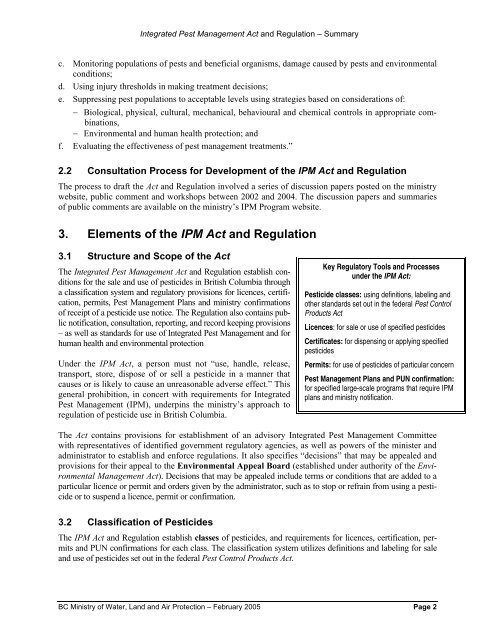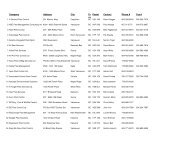Integrated Pest Management Act and Regulation Summary
Integrated Pest Management Act and Regulation Summary
Integrated Pest Management Act and Regulation Summary
You also want an ePaper? Increase the reach of your titles
YUMPU automatically turns print PDFs into web optimized ePapers that Google loves.
<strong>Integrated</strong> <strong>Pest</strong> <strong>Management</strong> <strong>Act</strong> <strong>and</strong> <strong>Regulation</strong> – <strong>Summary</strong><br />
c. Monitoring populations of pests <strong>and</strong> beneficial organisms, damage caused by pests <strong>and</strong> environmental<br />
conditions;<br />
d. Using injury thresholds in making treatment decisions;<br />
e. Suppressing pest populations to acceptable levels using strategies based on considerations of:<br />
− Biological, physical, cultural, mechanical, behavioural <strong>and</strong> chemical controls in appropriate combinations,<br />
− Environmental <strong>and</strong> human health protection; <strong>and</strong><br />
f. Evaluating the effectiveness of pest management treatments.”<br />
2.2 Consultation Process for Development of the IPM <strong>Act</strong> <strong>and</strong> <strong>Regulation</strong><br />
The process to draft the <strong>Act</strong> <strong>and</strong> <strong>Regulation</strong> involved a series of discussion papers posted on the ministry<br />
website, public comment <strong>and</strong> workshops between 2002 <strong>and</strong> 2004. The discussion papers <strong>and</strong> summaries<br />
of public comments are available on the ministry’s IPM Program website.<br />
3. Elements of the IPM <strong>Act</strong> <strong>and</strong> <strong>Regulation</strong><br />
3.1 Structure <strong>and</strong> Scope of the <strong>Act</strong><br />
The <strong>Integrated</strong> <strong>Pest</strong> <strong>Management</strong> <strong>Act</strong> <strong>and</strong> <strong>Regulation</strong> establish conditions<br />
for the sale <strong>and</strong> use of pesticides in British Columbia through<br />
a classification system <strong>and</strong> regulatory provisions for licences, certification,<br />
permits, <strong>Pest</strong> <strong>Management</strong> Plans <strong>and</strong> ministry confirmations<br />
of receipt of a pesticide use notice. The <strong>Regulation</strong> also contains public<br />
notification, consultation, reporting, <strong>and</strong> record keeping provisions<br />
– as well as st<strong>and</strong>ards for use of <strong>Integrated</strong> <strong>Pest</strong> <strong>Management</strong> <strong>and</strong> for<br />
human health <strong>and</strong> environmental protection<br />
Under the IPM <strong>Act</strong>, a person must not “use, h<strong>and</strong>le, release,<br />
transport, store, dispose of or sell a pesticide in a manner that<br />
causes or is likely to cause an unreasonable adverse effect.” This<br />
general prohibition, in concert with requirements for <strong>Integrated</strong><br />
<strong>Pest</strong> <strong>Management</strong> (IPM), underpins the ministry’s approach to<br />
regulation of pesticide use in British Columbia.<br />
Key Regulatory Tools <strong>and</strong> Processes<br />
under the IPM <strong>Act</strong>:<br />
<strong>Pest</strong>icide classes: using definitions, labeling <strong>and</strong><br />
other st<strong>and</strong>ards set out in the federal <strong>Pest</strong> Control<br />
Products <strong>Act</strong><br />
Licences: for sale or use of specified pesticides<br />
Certificates: for dispensing or applying specified<br />
pesticides<br />
Permits: for use of pesticides of particular concern<br />
<strong>Pest</strong> <strong>Management</strong> Plans <strong>and</strong> PUN confirmation:<br />
for specified large-scale programs that require IPM<br />
plans <strong>and</strong> ministry notification.<br />
The <strong>Act</strong> contains provisions for establishment of an advisory <strong>Integrated</strong> <strong>Pest</strong> <strong>Management</strong> Committee<br />
with representatives of identified government regulatory agencies, as well as powers of the minister <strong>and</strong><br />
administrator to establish <strong>and</strong> enforce regulations. It also specifies “decisions” that may be appealed <strong>and</strong><br />
provisions for their appeal to the Environmental Appeal Board (established under authority of the Environmental<br />
<strong>Management</strong> <strong>Act</strong>). Decisions that may be appealed include terms or conditions that are added to a<br />
particular licence or permit <strong>and</strong> orders given by the administrator, such as to stop or refrain from using a pesticide<br />
or to suspend a licence, permit or confirmation.<br />
3.2 Classification of <strong>Pest</strong>icides<br />
The IPM <strong>Act</strong> <strong>and</strong> <strong>Regulation</strong> establish classes of pesticides, <strong>and</strong> requirements for licences, certification, permits<br />
<strong>and</strong> PUN confirmations for each class. The classification system utilizes definitions <strong>and</strong> labeling for sale<br />
<strong>and</strong> use of pesticides set out in the federal <strong>Pest</strong> Control Products <strong>Act</strong>.<br />
BC Ministry of Water, L<strong>and</strong> <strong>and</strong> Air Protection – February 2005 Page 2



